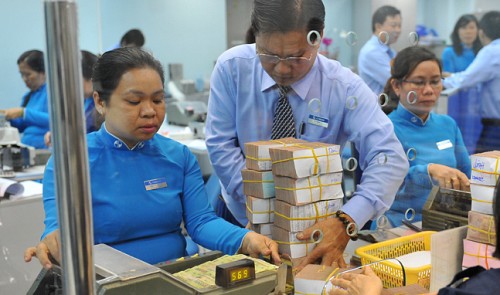The government has asked relevant state agencies to speed up their work on completing the operational procedures for the Vietnam Assets Management Co (VAMC) so that the firm can become fully operational this month.
The national asset management company, which is being set up to shore up the local banking system, which is choked by bad debts, had previously been planned to come online on Tuesday (July 9).
The state-run firm, which has VND500 billion ($24 million) worth of chartered capital, is expected to buy as much bad debt as it can to relieve the burden of local banks.
By helping boost bank lending, growth of which was stuck at 4.5 percent in the first half of this year, VAMC will indirectly spur the country’s economic growth, which is still lagging behind its, at 4.9 percent.
In a report aired last week, JPMorgan estimated that the introduction of the VAMC will be a positive step in helping to reform the banking system and unfreeze credit flows in Vietnam.
According to JPMorgan, the world has seen many banking crises, which, in turn, has generated a lot of ways to deal with these crises. The lessons indicate that the success of an asset management company is often dependent on many factors, including leadership - political agreement, transparency, independence and the regulatory environment.
JPMorgan is positive that VAMC will create liquidity for banks, allowing them to recapitalize themselves in the next five years, so the State Bank of Vietnam (SBV) does not have inject new capital into the system right away.
High hopes?
This year, SBV, which supervises VAMC, has estimated that the latter may tackle VND80-100 trillion ($4-5 billion) worth of bad debts, or 60-70 percent of total loans. The recovery rate for those debts is estimated at 20-40 percent.
However, VietCapital Securities Joint Stock Co (VCSC), in its latest report, said this plan is overambitious for the remaining months of 2013.
The company said VAMC will likely start buying back bad debt within the year, but it will only handle about 20 -30 percent of the total value of loans through the issuance of special bonds or direct debt purchases at market prices.
VCSC also said that the SBV’s plan to issue special bonds is a more viable option than the other, as the charter capital of VAMC is lower than the total sum of bad debts.
According to VCSC, there will be difficulties that could affect the performance of VAMC.
Unclear assessment and classification of banks' bad debt data and immature local bad debt and capital markets are the first two obstacles.
The remaining hurdles include no commitment of direct funding from the Government for VAMC, the lack of high-profile experts experienced in managing debt settlement companies, and the risk of intervention from interest groups in the local banking system.
The bank has suggested that VAMC has taken quite stringent requirements.
For example, bad debts that can be bought by VAMC are those secured by physical assets, in which no less than 65 percent of the total value of the collateral is realty properties or any form of properties in the future. The reasonable rate should be at 50-60 percent.
VCSC said, according to the State Bank, only 30 out of 124 local credit institutions reported that their bad debt rate is over 3 percent, and thus currently there is no information about which banks will get involved in the debt purchasing process.
According to JPMorgan, there are also negative points, including the fact that the local banking reform plans will take many years, so credit and economic growth will likely remain below potential during the period.
Fitch Ratings, in its latest report on VAMC, also said that the creation of an asset management company like VAMC, or "bad bank", to buy non-performing loans (NPLs) is unlikely to fully resolve the banks' asset-quality problems unless accompanied by meaningful regulatory improvements.
“With no fresh capital, the banks are likely to be limited in their ability to restructure and support the domestic economy.”
“We believe Vietnamese banks may still face capital-impairment risks even after offloading bad debt to the VAMC, based on preliminary data. This is because government-guaranteed bonds received in consideration for bad debt must be written off by a reported 20 percent each year, which effectively means that the bad bank only buys time for the banks to write off losses.”
“The banks are not receiving new capital, and the sovereign debt will not rise. But there may still be fiscal costs if this approach to tackle NPLs is not successful, and if the slow fix limits the banks' ability to support economic growth,” Fitch said.
“An alternative to the VAMC is to recapitalize the banking sector, but this may prove costly.”
“We believe system-wide NPLs to be three to four times higher than reported by the banks - greater than the understatement reported by SBV. The central bank reported that the NPL ratio was 8.8 percent at the end of September 2012, while the banks put this at 4.9 percent,” it said.
“If NPLs were higher - at 15 percent, perhaps - we estimate the cost of recapitalizing the banks may reach 10 percent of 2013 GDP,” Fitch added.























































